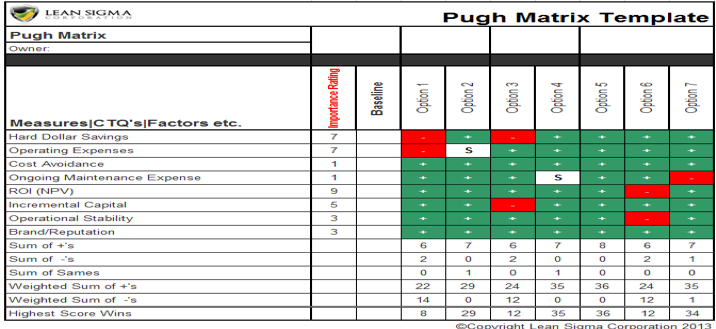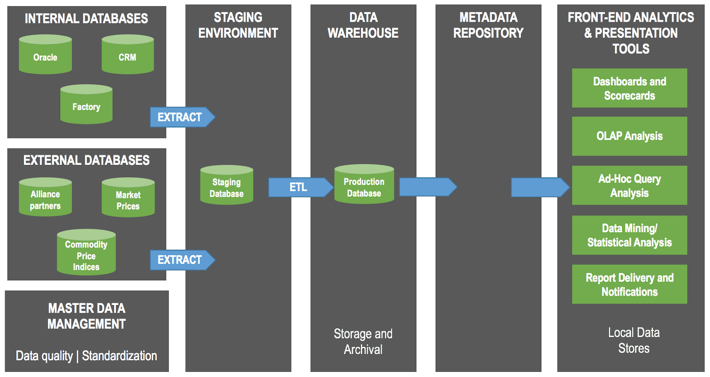Situation
Aventine operated in a volatile, narrow-margin business environment. In order to make data-informed decisions on the fly, employees needed to be armed with the most up-to-date information. Unfortunately, limited visibility to financial data severely diminished decision-making and strategic planning capabilities.
The finance department prepared static reports, but they had several drawbacks:
- They were only delivered once per month, which is not frequent enough.
- They were backward-looking, always a month behind.
- They were limited, excluding critical financial metrics.
- They were summarized, showing numbers in aggregate with no ability to drill down into data.
Not only are these reports inadequate, but they are also manual and time-consuming to produce. Moreover, because the reports do not meet the needs of employees, the finance department often has to spend additional time completing ad-hoc reports and analysis for specific requests.
Actions
I led effort to implement business intelligence software tools. Once tools were implemented, I developed a series of scorecards, dashboards, and reports to allow teams to monitor operational and financial performance. Specific activities are summarized detailed below.
01: I worked with business teams that needed access to data to understand requirements
Step 1: Conducted one-on-one stakeholder interviews with all parties:
- C-Level Officers
- Senior executive team members
- Management team members (multiple departments)
- Front-line employees (multiple departments)
Step 2: Organized all information, preparing various self-referencing documents that articulated business goals and requirements.
- Documents included
- Goals & Objectives – Enterprise & Departmental strategic objectives, Supporting KPIs and metrics
- Personas – Persona details, goals, List of tasks (What decisions does persona make with data?)
- Task Analysis – Data needed for each task. Steps involved in each tasks
- Dimensions & Measures – List of dimensions and measures required. Related personas./ Data permission level (to restrict visibility of sensitive data)
Step 3: Created wireframes which illustrated possible dashboard layouts
This was an iterative process which required continuous feedback from stakeholders
02: I worked with the finance department to understand data architecture of financial system and their process.
Step 1: Conducted stakeholder interviews with select members of finance team to discuss:
- Process used to create monthly reports
- Data points included on reports
- Financial assumptions
- Manual calculations
- Process used to conduct ad-hoc analysis
- Most common ad-hoc requests
- Pain points and challenges to compiling report and conducting ad-hoc analysis
Step 2: Updated previously created requirement documents with new information
03: I partnered with IT to identify and evaluate business intelligence tools that could integrate with the company’s financial system (Oracle ERP)
Step 1: I developed scoring criteria based on business and technical requirements
Step 2: I evaluated multiple business intelligence tools using a pugh matrix
- Pugh Matrix Template example

Step 3: I conducted a NPV analysis on the top 3 options
- NPV Analysis example

Step 4: I provided analysis and recommendations to C-level executives.
Ultimately, the three technologies that I recommended were selected.
- Technology selections



04: I led the effort to integrate financial system with business intelligence software.
Step 1: Worked with members of IT team to construct “as-is” data schema.
This schema visualized data architecture of the company’s Oracle ERP system (Oracle SQL Modeler)
Step 2: Conducted gap analysis; compared data schema to requirements to identify:
- Missing data points
- Missing dimensions
- Data that needed more granularity
Step 3: Worked with members of IT to construct and document the “to-be” data model.
Here is a visualization of to-be data architecture:

05: Developed 20+ scorecards and dashboards for each business audience which allowed teams to monitor operational & financial performance.
Audience:
- C-Level officers
- Senior executive team members
- Management team members (multiple departments)
- Front-line employees (multiple departments)
Each dashboard included:
- Filters to change dimensions (date, categories, etc.)
- Drill-down data for deeper analysis
To minimize cognitive load and increase understandability, every dashboard had 4 common sections.
-
- Data points related to enterprise objectives
- Data points related to departmental objectives
- Custom data points and/or views specific to each audiences needs
- Industry benchmarks and data points
Results
- Increased visibility to real-time, actionable data.
- Enabled better, faster decision-making.
- Improved strategic planning and financial reporting activities.
- Reduced time spent by finance teams on report generation, increasing accuracy and usefulness of data.